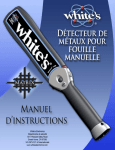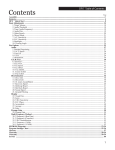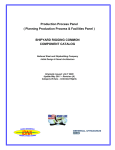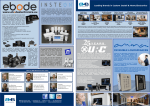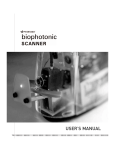Download Matrix 100 - Kellyco Metal Detectors
Transcript
888-778-9010 2 www.whiteselectronics.com Introduction The Matrix 100 Handheld Metal Detector is a world class security scanner. It is designed to meet and exceed the needs and specifications of today’s security conscious world, and complies with all National Institute of Justice standards for indoor/outdoor operations (IP 54). “Made in the U.S.A.” is a hallmark of White’s Electronics, the Matrix 100 utilizes the latest in electronic design technology that is both functional and attractive. The Matrix 100 Handheld Metal Detector is designed to detect metal and is primarily for security applications, however it is useful for a myriad of detection applications. Table of Contents Matrix 100 Features Front–View .....................................................................................................4 Back–View ......................................................................................................5 Top Edge .........................................................................................................6 Bottom Edge...................................................................................................6 Mechanical Drawing-metric Dimensions ..................................................6 Battery Door ...................................................................................................7 ON/OFF Button.......................................................................................................8 Sensitivity Control ..................................................................................................9 Volume Control for Earbud .................................................................................10 Testing the Scanner ...............................................................................................10 Batteries .................................................................................................................. 11 Battery Installation ...............................................................................................12 De-sense Button ....................................................................................................13 Earbud Jack ............................................................................................................14 Earbud Jack Rubber Plug.....................................................................................14 Lanyard ..................................................................................................................15 Scanning .................................................................................................................15 Three–year Warranty ............................................................................................19 Specifications .........................................................................................................20 Accessories .............................................................................................................21 Security Distributors ............................................................................................22 Contact Information .............................................................................Back Cover Features – Front view 888-778-9010 3 www.whiteselectronics.com Features—Front View Visual indicator LED De-sense button ON/OFF LED and Low battery indicator Lanyard hole ON/OFF button Audio speaker Battery door Features – Back view 888-778-9010 4 www.whiteselectronics.com Features—Back View Visual indicator LED De-sense button 20 Lanyard hole Sensitivity control access hole Volume control access hole cm Scan area Earbud jack with rubber plug Battery door 888-778-9010 5 www.whiteselectronics.com Features—Top Edge Battery door De-sense button Visual indicator LED 20 cm Scan area Lanyard hole Features—Bottom Edge Earbud jack and rubber plug Battery door 20 cm Scan area Mechanical Drawing-metric Dimensions 888-778-9010 6 www.whiteselectronics.com Features—Battery Door Battery door Stylus Battery polarization graphic 888-778-9010 7 www.whiteselectronics.com ON/OFF Button There are three selections for the ON/OFF button: • ON Audio • ON Vibrate • OFF ON Audio—press the ON/OFF button once. This will be followed by a single, double, or triple beep to indicate the current sensitivity level setting. The green ON indicator LED will emit a single flash for low sensitivity, double flash for medium sensitivity or a triple flash for high sensitivity. ON Vibrate—press the ON/OFF button twice. This will be followed by a single vibration burst and the ON indicator LED will emit a single flash for low sensitivity, double flash for medium sensitivity, or a triple flash for high sensitivity. The audio alarm is deactivated when the vibrate alarm is activated. OFF—Turn the unit off by pressing the ON/OFF button once. The ON indicator LED will disappear. ON/OFF indicator LED ON/OFF button Speaker Earbud jack 888-778-9010 8 www.whiteselectronics.com Sensitivity Control The unit is preset, at the factory, to medium sensitivity. The sensitivity level can be changed to the low, medium, or high level.* The Specifications List (see Page 20) shows the effect of the different sensitivity levels for detecting objects of various sizes. To change the sensitivity level, open the battery door and remove the stylus (see Page 7). Use the stylus to press the sensitivity control to cycle through the sensitivity levels,(low, medium, or high). The unit will beep or vibrate and will flash the red visual indicator LED to announce the new sensitivity level: One beep/vibration/flash = low sensitivity Two beeps/vibrations/flashes = medium sensitivity Three beeps/vibrations/flashes = high sensitivity When the unit is turned off or the battery is removed, the sensitivity level setting is retained in the memory. Visual indicator LED De-sense button Earbud volume Sensitivity Stylus * To be determined by administration policy and supervisor control. 888-778-9010 9 www.whiteselectronics.com Volume Control for the Earbud The unit is preset, at the factory, to medium earbud volume. Adjustments to volume must be made in audio mode. Press the volume control to cycle through the volume levels of low, medium, or high.* The unit will beep or vibrate and will flash the red visual indicator LED to announce the new volume level: One beep/one flash = low volume Two beeps/two flashes = medium volume Three beeps/three flashes = high volume When the earbud is plugged into the scanner, the audio speaker is deactivated. When the unit is turned off or the battery is removed, the ear bud volume level setting is retained in the memory. Earbud volume Stylus Sensitivity * To be determined by administration policy and supervisor control. Testing the Scanner • Turn on the scanner in the “ON Audio” or “ON Vibrate” mode. • Pass the scanner over a metal test object to ensure the LED, audio alarm, or the vibrate alarm are functioning properly. If the battery is fresh or recently recharged (more than 7V), the LED next to the ON/OFF button will produce a green light (see Page 8). If the battery is discharged to less than 7V, the LED will produce a yellow light and it is recommended that you replace the battery. 888-778-9010 10 www.whiteselectronics.com Batteries One 9V battery is included with the Matrix 100. Use a 9V-alkaline, 9V-lithium-manganese dioxide, or externally charged 9V-battery. If the battery is fresh or recently recharged (more than 7V), the LED next to the ON/OFF button will produce a green light. If the battery is discharged (less than 7V) the LED will flash a yellow light and it is recommended that you replace the battery. Battery Life Based upon measurements, battery life for a 600 mA-hour alkaline battery at room temperature is: ON OFF Hours 216 2880 Days 9 120 Battery life is doubled with the 1200 mA-hour lithium-manganese dioxide batteries. Rechargeable 9V batteries can also be used, but battery life per charge is typically much shorter than the life of 9V-alkaline batteries, and depends upon the battery type and the battery recharging system. WARNING DO NOT use the earbud jack as a recharging port! Use of the earbud jack as a recharging port may damage the Matrix 100 or the battery charger, and will void the warranty. Battery Temperature Ratings Alkaline batteries are rated by the following manufacturer: Energizer -18°C to 55°C (0°F to 130°F) Panasonic -20°C to 54°C (-4°F to 130°F) Lithium-manganese dioxide batteries are rated by the following manufacturer: Duracell -20°C to 60°C (-4°F to 140°F) Energizer -40°C to 60°C (-40°F to 140°F) Ultralife -20°C to 60°C (-4°F to 140°F) Manufacturer’s ratings are based upon operating loads quite different from the Matrix 100, so it is possible to have different results. * For information about special batteries that will operate at temperatures as low as -40°C contact White’s Electronics, Inc. 888-778-9010 11 www.whiteselectronics.com Battery Installation • Gently slide the battery door open. • Slide a 9V battery into the battery cavity as shown below. • Close the battery door. L 888-778-9010 12 www.whiteselectronics.com De-Sense button On the top edge of the scanner, there is a large rubber “De-sense” button.When depressed, this button will reduce the detectors sensitivity by approximately 50%. This is particularly useful when scanning near rebar reinforced floors. The “De-sense” is only activated as long as the button is depressed. While the “De-sense” button is pressed the ON/OFF LED (see Page 4) will illuminate continuously. If the battery is good, the LED will be green. If the battery is low or defective the LED will be yellow. Visual indicator LED De-sense button 888-778-9010 13 www.whiteselectronics.com Earbud jack The earbud jack accepts a 3mm or 1/8" “Mono” connector. Earbud jack Earbud Jack Rubber Plug The rubber plug helps protect the earbud jack against dirt and moisture. Earbud jack rubber plug 888-778-9010 14 www.whiteselectronics.com Lanyard A lanyard is provided with each Matrix 100. The small nylon loop can be threaded through the lanyard hole and looped back through itself to secure the Matrix 100. The lanyard is tested to withhold approximately 25 pounds of force, before breaking. Scanning a Person • Warning: Follow the approved policy & procedure for scanning a person. This policy & procedure should be approved by the administrator and/or supervisor of the person using the scanner. • It is recommended that the operator “NOT” touch the individual being scanned with the detector. • The detector is not a weapon and should not be treated as such and will void the warranty. • Treat the detector with care. Do not abuse. National Institute of Justice Guidelines for use of handheld detectors in schools. While it is not difficult to learn to use a handheld metal detector correctly, school administrators should not underestimate the value of annual training for their operators, as well as training for staff who may be called upon to serve as backup or supplemental operators. However, on-the-job practice is important in allowing the school to achieve the type of throughput that will be required in order to process students quickly. Every school will want to tailor its own set of operator procedures to take into consideration its students’ and community needs. Some generic procedures: • The detector should be passed over the scannee’s body at a distance of no more than 3 to 4 inches. Avoid touching the body or clothing with the detector. However, for some baggier clothing, such as pants or jackets, it may be necessary to hold the detector against or more into the fabric while scanning in order to stay within 3 to 4 inches of all body surfaces. 888-778-9010 15 www.whiteselectronics.com Scanning a Person • Most handheld metal detectors should be set at their highest sensitivity; an exception to this is if there is significant interference from metal reinforcing in a floor or other nearby material that could cause constant alarms unless the detector’s sensitivity is turned down. • The body scan should be performed each time in the same pattern so that the operator always knows what parts of the body still need scanning. A sample routine is illustrated on Page 18. 1. Ask the scannee to place all carried items, plus any caps or headgear on a table (procedures for manual search of baggage are not covered in this text). The scannee should stand with his or her feet about 18 inches apart, facing away from the table and about 2 feet in front of it. Footprints outlined on the floor or drawn on a mat can greatly help position the scannee properly. Ask the scannee to hold his or her arms out to the sides, parallel to the floor. 2. Quickly run the handheld detector across some piece of conductive material on your own body, such as a belt buckle. The ensuing squeal of the detector will assure you that the scanner is still operating properly. 3. Start at the top of one shoulder of the scannee. With the paddle of the detector held horizontally and parallel to the front of the body, sweep down one side of the front of the torso, down the leg to the ankle, then move to the other ankle and sweep back up the front of this opposite leg and torso, ending with the opposite shoulder. (If a particular detector’s detection paddle is less than half the width of the average body, or if a particular body is wider than twice the width of the detection paddle, the pattern will have to be modified to achieve adequate coverage). 4. Sweep the detector paddle over the outside top of the arm from the top of the shoulder to the bottom of the wrist, then up the inside of the arm to the armpit. Sweep down that side of the body to the ankle, then up the inside of that leg and down the inside of the opposite leg, then back up the other leg from the ankle to the underarm. Repeat the sweep of the inside and outside of this arm. Note that it would be particularly important to avoid touching the paddle up against the scannee’s body when scanning up and down between the legs. 5. Ask the scannee to turn around. (Arms can be put down now). The pattern used to scan the front of the body should now be repeated over the back of the body. 6. Ask the scannee to grab the edge of the table for support, then to lift one foot up in back of him or herself. Scan across the bottom of the shoe. Repeat for the other foot. The operator should expect to hear a short squeal from the detector when scanning the bottom of shoes or boots with steel shanks or steel toes. Both shoes should cause equivalent squeals. 7. For the head area, start at the top of the forehead and scan around the 888-778-9010 16 www.whiteselectronics.com Scanning a Person top of the head down to the back of the neck. • When the detector identifies a suspicious item and there is no visible source for the alarm (clothing is shielding the source object), ask the person to show you what they have in that area. For example, for an alarm along the arm or wrist, have the scannee pull up his or her shirt sleeve. Using your detector, duplicate the squeal you heard before, but now over the visible item. • Do not let the scannee influence you as to what is actually causing an alarm. For instance, if the detector denotes the presence of a suspicious item under a shirt sleeve, do not fail to completely investigate the source of the alarm even though the scannee assures you that it is just his or her watch. • If the person you are about to scan caused an alarm when walking through a portal metal detector, and your job is to try to locate the source of that alarm on his or her body, do not stop the complete scanning process just because you come across one alarm-causing item. Continue the scan even though you find one or more items in the process. • The lower abdominal area is particularly difficult to scan because this area is private in nature and because of the metal items usually found in this area: belt buckles, metal buttons or snaps, and metal zippers. When doing the initial front body scan, if an alarm occurs in this area, there are two possible ways to further investigate: a. Ask the scannee to undo any belt he or she might have on and have him or her pull the belt ends away from the middle of the body. Now scan the zipper area; your handheld metal detector should tell you if it is now only sensing a zipper and/or a metal snap, or if a more suspicious item is present and further investigation is needed. b. A second approach that some schools use is that, if the lower abdominal area is causing an alarm on the handheld detector, ask the scannee to bend the front of his or her front waistband forward, to ascertain that no weapon is hidden behind it. Facilities need to be available for situations where further investigation can be accomplished privately, but only in the presence of two or more school employees who are the same gender as the scannee. 888-778-9010 17 www.whiteselectronics.com Scanning a Person This is an example of procedures for using a handheld metal detector that has at least a 10-inch zone of direction. (The preceding guidelines and illustrations were produced by the National Institute of Justice in their report titled The Appropriate and Effective Use of Security Technologies in U.S. Schools. National Institute of Justice, U.S. Department of Justice: Washington, DC (September 1999) Available online at: http://www.ojp.usdoj.gov/nij/pubs-sum/178265. htm) There have been no conclusive studies showing that the magnetic fields generated by handheld metal detectors will or will not affect personal medical electronic devices (PMEDs), such as pacemakers, cardiac defibrillators, infusion pumps, spinal cord stimulators, etc. Therefore, caution should be used when operating handheld metal detectors near people with the PMEDs. 888-778-9010 18 www.whiteselectronics.com Three–year Warranty The Matrix 100 is warranted by White’s Electronics, Inc., under normal use, against manufacturing defects for three years from the date of purchase. Equipment returned to an authorized repair center or to the factory during the warranty period will be inspected and evaluated under the performance specifications. White’s Electronics will repair or replace, at no charge to the owner, all parts determined to be faulty. Items not covered by this warranty are as follows: • Batteries • Failures caused by abuse • Tampering with the internal electronics • Battery leakage • Repairs made by an unauthorized party • Contaminants • Use in adverse conditions. Returns must be prepaid and shipped to: Whites Electronics, Inc. Security Division Repair Department 1011 Pleasant Valley Road Sweet Home, OR 97386 1-541-367-6121 Specifications Alarm Battery Consumption Dimensions Length Width Thickness Operating frequency Weight With Battery Without Battery 888-778-9010 Visual indicator LED with audio or vibrate function 2.8 mA 16"/41 cm 2 ¾"/3 cm 1.17"/3 cm 125 kHz 11.1 oz./316 grams with battery 9.5 oz./269 grams without battery 19 www.whiteselectronics.com Specifications List st NIJ Matrix 100 Specification Sensitivity Level 0602.03 High Medium Low Sensitivity measured from surface of detector to surface of object) Large object size class (zinc gun) Scan speed 0.5 to 2.0 m/s 8 cm (3.1") 11.6 cm 8.6 cm 5.7 cm Scan speed 0.1 m/s 5 cm (2") 11.6 cm 8.6 cm 5.7 cm Medium object size class (steel knife) Scan speed 0.5 to 2.0 m/s 6 cm (2.4") 11.5 cm 9.4 cm 6.3 cm Scan speed 0.1 m/s 5 cm (2") 11.5 cm 9.4 cm 6.3 cm Medium object size class (aluminum knife) Scan speed 0.5 to 2.0 m/s 6 cm (2.4") 7.0 cm 5.3 cm 3.5 cm Scan speed 0.1 m/s 5 cm (2") 7.0 cm 5.3 cm 3.5 cm Small object size class (steel handcuff key) Scan speed 0.1 to 2.0 m/s 3.5 cm (1.4") 7.3 cm 5.6 cm 3.1 cm Very small object size class (brass pen refill) Scan speed 0.1 to 2.0 m/s 1.5 cm (0.6") 5.2 cm 3.1 cm 1.9 cm Extremely small object size class (18-gauge stainless hypodermic needle) Scan distance and speed Undefined 1.2 cm 0.2 cm NA Large metal panel interference alarm distance Less than 50 cm 43 cm 33 cm 21 cm (19.7") Scan area is cylindrical 28 cm long. Diameter is 2x the sensitivity distance for the object class plus 2 cm. Scan speed All object size classes 0.1 to 2.0 m/s 0.05 to 3.0 m/s Scan range Large object size class Scan speed 0.5 to 2.0 m/s +/- 8 cm (3.1") Scan speed 0.1 m/s +/- 5 cm (2") Medium object size class +/- 10 cm (3.9" ) at scan Scan speed 0.5 to 2.0 m/s +/- 7 cm (2.8") speeds from 0.05 to 3.0 m/s Scan speed 0.1 m/s +/- 5 cm (2") for all object size classes Small object size class Scan speed 0.1 to 2.0 m/s +/- 5 cm (2") Very small object size class Scan speed 0.1 to 2.0 m/s +/- 2 cm (0.8") Operating temperature (NIJ indoor/outdoor) -37°C to +65°C -40°C to +85°C -35°F to +149°F -40°F to +185°F Relative humidity 95% 20°C to 60°C 95% 20°C to 60°C Audible alarm volume 75 dB at 80 cm 85 dB at 80 cm Battery One 9V Battery life 16 hours 19°C to 23°C 9V–Alkaline 215 hours 9V–lithium 430 hours Body interference No alarm when touching hand No alarm when touching hand Electromagnetic emission CISPR 22, Class B CISPR 22, Class B Weight Less than 500 g 316 g (11 oz) with battery Operating frequency 125 KHz Peak magnitude of generated magnetic field at surface of detector 0.2 gauss Requirement 888-778-9010 20 www.whiteselectronics.com Accessories Batteries/Chargers Lithium-manganese dioxide battery (-20°C to +60°C) 9V rechargeable battery 4 Station Charger 10 Station Charger Earbud Earbud Jack Plug Holster Lanyard Stylus Matrix Security Support, Academy, Store, Security Support FAQs On-line Chat Telephone Email Security Academy Security Store The Security Academy offers hands-on training instruction at your facility, by our security experts, to train and guide your Security Staff in the most up-to-date security technology available. Ballistic Nylon Briefcase Prices available on request. Lanyard Batteries Battery Chargers Caps DVD Earbud Earbud Jack Plug Holster Shirts Stylus Sweatshirts Warm–up–suits For addition information regarding Security Support, Academy, or Store please visit our web site at www.whiteselectronics.com or call our friendly Customer Service Representatives at 888-778-9010. Maintenance Perform daily inspection to ensure the Matrix 100 is operating properly. Inspect the battery to ensure it is “fresh” or charged and that the Matrix 100 is clean. 888-778-9010 21 www.whiteselectronics.com Security Distributors Western Region Randy Smith Alaska Arkansas Arizona California Colorado Hawaii Idaho Iowa Kansas Louisiana Mississippi Missouri Montana Nebraska Nevada New Mexico Oklahoma Oregon Texas Utah Washington Wyoming Central Region Mike Brighty Eastern Region Mike White Alabama Florida Illinois Indiana Kentucky Michigan Minnesota North Dakota Ohio South Dakota Tennessee Wisconsin Connecticut DC Delaware Georgia Maine Maryland Massachusettes New Hampshire New Jersey New York North Carolina Pennsylvania Rhode Island South Carolina Vermont Virginia West Virginia Canada Mexico Caution: Any device changes or modifications not expressly approved by Whiteʼs Electronics, Inc. could void the userʼs authority to operate this equipment. NOTE: This equipment has been tested and found to comply with the limits for a Class B digital device, pursuant to Part 15 of the FCC Rules. These limits are designed to provide reasonable protection against harmful interference in a residential installation. This equipment generates, uses and can radiate radio frequency energy and, if not installed and used in accordance with the instructions, may cause harmful interference to radio communications. However, there is no guarantee that interference will not occur in a particular installation. If this equipment does cause harmful interference to radio or television reception, which can be determined by turning the equipment off and on, the user is encouraged to try to correct the interference by one or more of the following measures: -- Reorient or relocate the receiving antenna. -- Increase the separation between the equipment and receiver. -- Connect the equipment into an outlet on a circuit different from that to which the receiver is connected. -- Consult the dealer or an experienced radio/TV technician for help. This device complies with part 15 of the FCC Rules. Operation is subject to the following two conditions: (1) This device may not cause harmful interference, and (2) this device must accept any interference received, including interference that may cause undesired operation. This “Class B” digital apparatus complies with Canadian ICES-003. Cet appareil numériqué de la “classe B” est conformé à la norme NMB-003 du Canada. 888-778-9010 22 www.whiteselectronics.com Security Distributors Washington Montana North Dakota Oregon Idaho Vermont Minnesota Wyoming Pennsylvania Iowa Utah California New York Michigan Nebraska Nevada New Hampshire Wisconsin South Dakota Illinois Indiana West Virginia Massachusettes Rhode Island Connecticut New Jersey Delaware Maryland Ohio Colorado Kansas Maine Virginia Kentucky Missouri North Carolina Arizona Oklahoma New Mexico Tennessee South Carolina Arkansas Mississippi Alaska Alabama Georgia Texas Louisiana Florida Hawaii Randy Smith, Western Region - Tulsa OK Phone: 1-888-778-9010 [email protected] Michael Brighty, Central Region - Toledo OH Phone: 1-888-778-9010 [email protected] Michael White, Eastern Region - Boston MA Phone: 1-888-778-9010 [email protected] 888-778-9010 23 www.whiteselectronics.com METAL DETECTORS SECURITY DIVISION 1011 Pleasant Valley Road Sweet Home, OR 97386 1-888-778-9010 Toll Free 541-367-6121 Voice 541-367-7990 Fax TM P/N 621-0495 Printed in USA 04/07
























